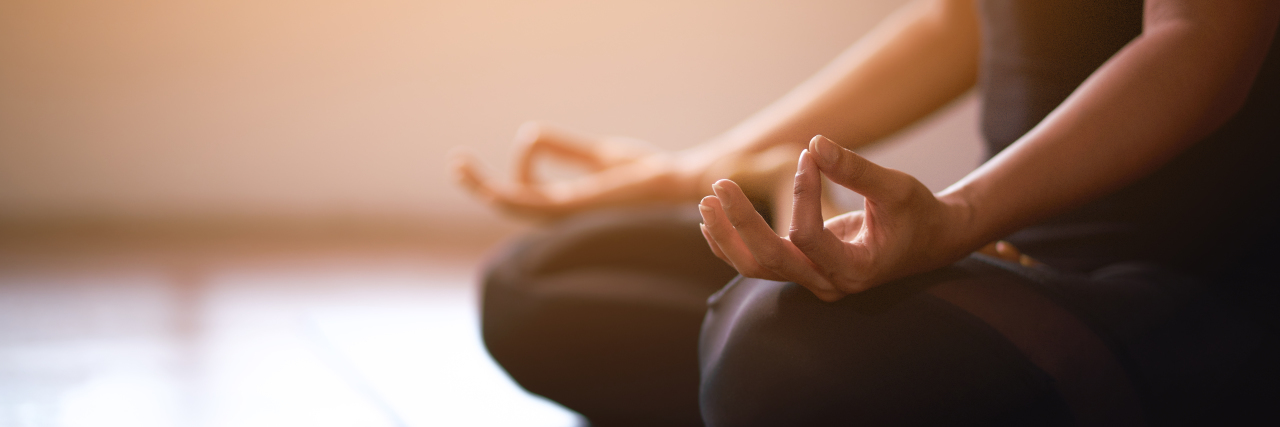When I recently listened to the Yoga Is Dead Podcast episode “Vegans killed yoga,” it first made me reflect on the need to stop prioritizing the way our bodies look. But then, as I thought more about it, I realized we also need to stop idealizing certain ways our body can act. To do anything else is to further enable the culture of ableism commonly seen in yoga and other wellness communities.
The podcast talked about a man who was upset by the fact that some yoga classes were called “advanced,” when on some days for someone with chronic illness “advanced” is getting out of bed. As someone who has experienced chronic illness, I immediately connected to this feeling. It isn’t fair to label some actions as for “more advanced yogis” when in fact, it has nothing to do with your ability to do yoga. It has to do with physical ability. And for some, that might look different.
For me, there are days when getting out of bed is not possible, and there are other days when I can get up but I could never dream of doing an “advanced” yoga class. And other days, those are my favorite things. But on the days when it isn’t possible, the last thing I need is someone else telling me that I “should” be able to do that. That as a yoga teacher, or someone who has been practicing yoga for a long time, I should be at a high enough level to do that. Because my ability to practice yoga should have nothing to do with what my body can physically do on any given day. On those days, the voice in my head usually makes me feel guilty enough for things I can’t do. If I can go to a yoga class or practice yoga at home, there is no reason I should feel guilty for what that practice looks like or doesn’t look like.
Yoga is defined as “the ability to direct the mind without distraction or interruption” according to Patanjali’s Yoga Sutras. This text is often considered by yoga teachers and experts to be the standard guide to yoga, as it outlines basic principles that yoga follows. In this definition, it says nothing about the physical body. Similarly, in the Bhagavad Gita as translated by Eknath Easwaran, Krishna (the embodiment of The Self) says, “yoga is perfect evenness of mind.” (Easwaran 94). Yoga isn’t about contorting your body into poses for pictures on Instagram. Some of the most accomplished yogis in the world never practice many of the asanas. Monks are advanced yoga practitioners, even those who sit still for hours every day, for they are practicing evenness of mind. Yoga literally means “to yoke” or the union of body, mind and soul. Thus, yoga is any practice that unifies the body, mind and soul.
In my own life, I have seen the negative effects of this type of language. In college, I never went to “power yoga” with my friends. I was too sick to be able to do the physically demanding poses, and I didn’t want to be judged as not being “good at yoga.” The class was very fitness-based, and people didn’t go to that class who couldn’t keep up. I once heard people laughing about the “old people” who came to the class and “couldn’t even do the two-minute planks.” After that, I knew I would never go to that class. There have been times in my life when I can do those planks, but at that point in my life, I would often be in tears of pain just from walking to class. Why would I subject myself to a yoga class where I would be mocked for not being able to keep up?
Luckily, I found another workshop that was based on mindfulness and reflection that allowed me to practice yoga in a group setting that wasn’t physically demanding. I could go there no matter how I was feeling, and knowing that made me always feel welcome and part of the group; they would accept me even knowing that I was sick. These experiences have shown me how personal the problems ableism creates can be. I already felt so guilty about my physical disabilities during those years that I would never have put myself in a setting where my ability might be questioned. Until I found that mindfulness course, I avoided any mention of yoga because I feared my body “couldn’t do it anymore.”
I realize that yoga teachers need a way to set “levels” for their courses so students can know what to expect. I plan to use an idea that was used to describe our college orientation trips: flavors of salsa. The most physically demanding classes will be “spicy,” moderate-intensity will be “medium,” and less active/restorative classes will be “mild.” This way, there is no correlation between yoga “skill” and the type of class.
How can you make the language you use in your yoga classes more welcoming to all? This week, as you practice yoga in your own practice and in classes, be aware of ableism as it appears. Be gentle with yourself first: it’s OK if you can’t do every pose or it doesn’t look the way you wish it did. Remember, there is no way that yogis are “supposed to look.” Be yourself, and be proud of it.
This story originally appeared on Purple Garlic.
Getty image by goo.gl/73nyq6

